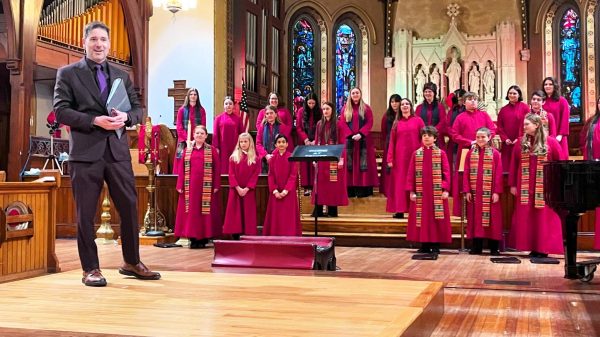KENT—Back in the 16th century, so legend goes, Martin Luther was returning home through the forest one winter night when he stopped to admire the beauty of an ice-laden tree sparkling in the moonlight. He was so impressed that he chopped down a tree and dragged it into his house, where he lighted candles on its branches so his six children could share in the glory of the moment.
Thus, Martin Luther may have been the first in history to go out into nature to select and cut his own Christmas tree.
The Christmas tree, a decidedly Germanic contribution to American culture, has become firmly rooted in modern Yuletide tradition. But this year, the trend established 700 years ago has become stressed. Christmas tree sales are vigorously underway, but vendors have been challenged by a lack of inventory.
St. Andrew’s Church started its sales last weekend after a herculean effort to secure trees. Church member Stephen Morocco said he began the search months ago, reaching out to 85 different Christmas tree growers in five different states. Receiving not one reply, he went on to email and call growers. “I was told again and again, ‘forgeddaboudit,’” he reported. “There are no trees to be had due to a national shortage.”
He finally connected with a grower on the Vermont/Canada border named “Alain.” “We hit it off instantly because I said his name correctly,” Morocco said. “I joked that probably NOBODY calls him by his correct name. Alain said, ‘Not in America.’”
Even Alain said he could not help until Morocco “went into begging mode,” describing how his church needed the funds. Eventually, he negotiated for 220 trees, but of only one species—balsam—and virtually all the same size. The trees arrived in Kent early on the morning of Nov. 20 where they were unloaded by volunteers and prepared for sales that began last weekend.
According to Lisa Angevine-Bergs, executive director of the Connecticut Christmas Tree Growers Association, the problem is nationwide, but does not refer to the number of trees being grown, but rather to the size of trees that customers want.
“The issue is there’s not a lot of taller trees,” she said, adding that the current situation grew out of a “perfect storm” of events. First, there was a significant and prolonged drought six or seven years ago. “Any of the little trees that hadn’t had a chance to establish their roots, died. It takes eight to 10 years to grow a Christmas tree [to the desired height] and they were the ones that would be ready now.”
Then, during Covid, people were trapped in their homes and “everyone was home together and wanted to experience something as family—2020 was a record year and they went for the big ones,” she said.
With the truly large trees decimated in 2020 and Covid persisting into 2021, buyers “went for the six footers the next year,” Angevine-Bergs reported. “I think this area got hit hard because of its proximity to the city and the New Yorkers all want big trees.”
At the same time, the value of property escalated sharply and many of the “backyard growers” became disenchanted with the backbreaking work of raising trees and took the profit in their lands.
“Customers don’t understand,” Angevine-Bergs said. “People are so unhappy.”
She anticipates that a number of tree farms in the area will close early this year. Her own farm, Angevine Farm in Warren, a popular source in the region, is selling trees only by reservation and reservations are now closed.
“We only had about a third of the inventory we would like,” she said. “We would rather have people know in advance. It would be bedlam on the farm if we just let people come.”
Lack of inventory and escalating prices have forced some traditional vendors, such as gas stations and local civic groups, out of the market. A median price for a tree in Connecticut is $75 this year, with larger trees costing $90 or more.
Up in Falls Village, Housatonic Valley Regional High School is holding its annual sale as usual, according to FFA President Kara Franks. “We have our usual distributer, so really we had no issues,” she said. “We got about 800 trees and sold quite a few this past weekend. It surprises me every year how quickly they go.”
She said that as in recent years, prices are up again. “We don’t have many 15-footers, but they cost $250. The average is $75 to $80.”
The FFA sale also provides wreaths, house decorations, kissing balls and cemetery boxes. A popular event every year is production night when family and community members are invited to help replenish stock by making wreaths. “The next one is Thursday (tonight),” she said. “It’s kinda cool to make a wreath from start to finish.”
Angevine-Bergs says the current crunch could last two or three years but will soften with importation of trees from areas like North Carolina, Vermont, Maine, Canada and Pennsylvania. “We want people to go to the the Connecticut Christmas Tree Growers Association website and search the area for a farm. The story is that this is really a family experience. Increasingly, it is a special time for families. Going together and getting their own tree is such an important thing for them.”
Local vendors include:
Kent Greenhouse, which has live and cut trees in various sizes, as well as wreathes and decorations.
Ace hardware, which sells artificial trees, greenery, decorations and the like.
Windswept Tree Farm, 12 Evergreen Lane, in New Milford, where customers can choose and cut their own tree.
And, Lappala Christmas Tree Farm, 2 Upland Road, New Milford, which is advertising blue and white spruce trees ranging it height from 5 to 7 feet.





























